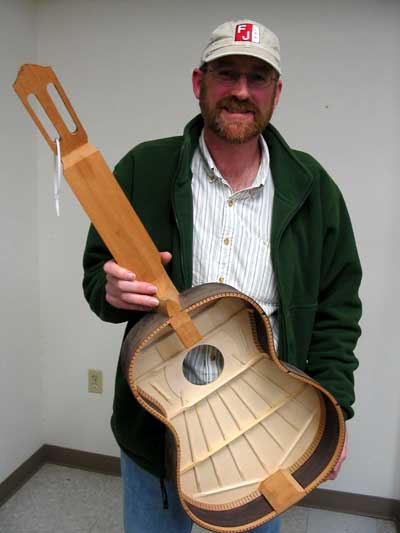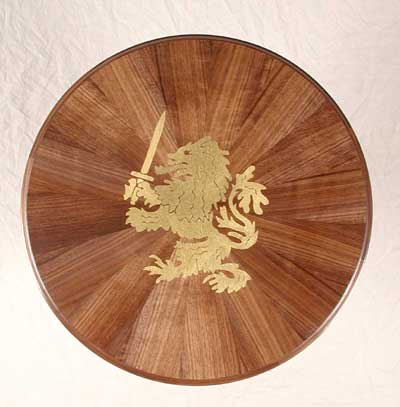
Last meeting
![]()
Our January meeting started out with Announcements. Rafflemeister Stan Booker brought in three goodies for the raffle. Zebra wood and a Wenge board and a fence system donated by Woodline. Remember, $1 per ticket or 6 for $5. For 30 or more tickets see Stan and bargain! Door prizes include magnetic strip tool holders and a router book. Stan also described his program to send used hand tools to Tanzania. The chisels Fred Reicher sharpened are on their way. If you have doubles of any hand tool, bring it to Stan. Neal White described the Silent Auction items of a hand plane also a Craftsman grinder.
The Woodworking show will be in Santa Clara April 21 to 23. Tony Fanning who normally coordinates and sets up and manages the show will be out of town. Grandparents duties in England, you know. Your help is needed. See the THIS AND THAT column. Richard Winslow had cut offs of Teak and Cherry for the taking.
Per Madsen who is now in charge of the Program Committee announced that tool discussions will be part of the Tech Talk program segment.
The club received an inquiry from a member saying they would be leaving the area for a couple of years and wondering if anyone wants to baby sit their 24 x 80 inch Ulma workbench. See the CLASSIFIEDS for details.
Arnie Champagne will hold classes in February and March for hand planes and dovetails, respectively. See the CLASSIFIEDS.
Harold Patterson said that there will be a March Toy Workshop. He has to defer for a while since his father is not in good physical shape. He has an older Shopsmith band saw he will sell cheaply.
Show and Tell
Paul Reif brought in two Monkey Pod bowls made from the crotch of a tree salvaged in Hawaii. The bowls are 1 ½" thick and 12" in diameter. Monkey pod cuts, machines and sands easily. He finished the bowls with a Liberon oil, reducing the gloss by rubbing with 5/0 steel wool. If you bring back wood from Hawaii, you must first remove the bark to ensure that all insects stay home.
Glenn Krueg brought in a turned Poplar bowl finished with gold and silver leaf foils. He coated the foil with 20-30 coats of lacquer and sanded the bowl to a 6000 grit finish. He used auto body polish to achieve the final 15000 grit surface finish.

Rick Dahlgren showed two wood toys he made for his grand children. The toys are strong enough to support the weight of a 30 pound boy.
Brad Heinzen showed the club members an acoustic guitar he is making. The front was left off to reveal the heavy bracing inside. Such a guitar takes about 80 hours to complete.

Claude Godcharles brought in his Didgeridoo again. He had reworked the inside to thin the walls. First he used a gouge, then a rasp on an extension handle, followed by a copper pipe with a sharpened tip. All of these techniques proved to be too difficult in such an long instrument. So he simply cut it in half on the bandsaw and used gouges to reduce the wall thickness. The weight of the instrument was reduced from 10 to 4 pounds. For all you members who snore, Science magazine has recently published an article claiming that playing the Didgeridoo can reduce the incidence of sleep apnea by 62%.
David Reese brought in an elegant Mission style standing mirror made of White Oak. Because of the open grain in the wood, there were some staining issues. He used an alcohol based dye.
Bill Henzel then called for guests to stand up and tell us a little about themselves. First was Ken Rauen from Palo Alto who does no woodworking but is involved in the manufacture of loudspeakers. He found us on the web. Next was Jim Holley from Half Moon Bay who heard about us from George Comstock. He is just starting. From Berkeley comes Chris Killion who does theater set construction. Saw us on the web. Scott MacFarlane of San Carlos does custom furniture and cabinets hails from San Carlos and heard of us at Woodcraft. He also joined. Welcome Scott.
The Tech Talk this evening was by Jamie Buxton -- Guilding Wooden Furniture with Metallic Foils.
Metal leaf foils are used to apply design accents to wooden furniture. The metallic leaf is very thin. It is purchased as individual sheets of foil layered between sheets of paper in a booklet format. Available foils include gold, silver, palladium, copper and aluminum. Only the gold will not tarnish. Copper is the most versatile material since it can be purchased with various surface patinas. Once the foil is applied, it is protected with a varnish cover coat.

The steps in the process are:
- Sand the wood to the desired finished grit level
- Apply two coats of varnish as a pore sealer
- Sand back the sealed wood
- Make the drawing first on paper, apply a grid to the drawing
- Apply the same grid to the accent location on the wood
- Transfer the drawing from the paper to the wood
- Apply the special sizing (varnish) to the design area. Let it become tacky (approximately 3 hours after application) , then apply the foil
- Let the applied foil dry for 3 to 4 days
- Apply 3 or 4 coats of varnish and rub out to 2400 grit surface finish
- Wipe on a thin final coat and final wipe with naphtha.
Suppliers of foil and related products are Houston Art www.houstonart.com , Sinopia (in SF.) www.sinopia.com and Gilded Planet www.gildedplanet.com.
The evening's Featured Presentation was Mark Dutka of InHouse Design Studio, San Francisco. His subject was The Design and Planning for a Home Office.
Mark received his degree in Interior Architecture from the California College of the Arts. He has two Master's degrees from the University of Pennsylvania, in City Planning and Social Work. In 1995 he founded InHouse Furniture and Design, a store on Van Ness Avenue in San Francisco dedicated to high end custom home offices. In 2001, the store evolved into InHouse Design Studio, specializing in home offices, custom designed furniture and cabinetry and specialty interiors, including media centers. Mark designs the office layout and components and has the units manufactured to his specification.
Mark has found that his training in social work has been most useful in helping to understand the needs of his clients in planning home offices and media centers. His strengths are in organizing spaces, design and helping people to articulate their ideas. Frequently, he finds that he uses his mediator skills to develop a cohesive plan.
The InHouse Design Studio is located in Mark's house in the Noe Valley neighborhood of San Francisco. His work has been featured in several prominent magazines and publications. The studio is advertised in San Francisco magazine. Prospective clients understand from the outset that these home offices are high end. Clients are asked to visit the studio with photos of their home and the proposed space for the home office. In the studio, they are greeted in Mark's own InHouse Home Office, incorporating all the ideal office features he recommends. He gives clients a planning guide to facilitate their journey, then schedules a visit to see the home. He asks them to consider how personal office items, favorite mementoes, space for equipment and lifestyle will be incorporated into their new home office. He tells them that when it comes time to install the office, he must have total access to the house at all times. It is impossibly disruptive to have to schedule an installation in fits and starts as it is being performed by electricians, cabinet makers and craftsmen. He makes sure he is on site during the installation since it is a highly personal experience for clients.
He favors linear and L-shaped office designs. Corner desk units are not favored because of the inefficient use of space in this configuration. Some of the design parameters he favors include:
- An articulated keyboard tray below desk level and angled for correct hand and arm posture
- A pull out tray inside a cabinet for the CPU unit of the computer
- Cabinets for all peripheral equipment, including printers, scanners, and fax machines
- A damn good ergonomic chair
- A computer monitor at eye level, or slightly below
- Good lighting and window screening to reduce/prevent glare
- Hidden wire troughs to unobtrusively route all electrical cables and conduits
Home offices are designed with the flexibility to accept new technology. Wireless communication and connectivity is becoming increasingly popular. He is careful, however, not to be too specific since product designs and components are evolving rapidly.
Mark Dutka had given us inspiration to think about our own ideal home offices.
There was no raffle drawing at the end of the meeting since not enough tickets were sold. Come back next meeting and BUY. However, the door prizes! Dave Reese walked away with a bunch of 12" Magic Ties. Bob Hulgan with a Router Jigs & Techniques book and Ken Rauen with a magnetic strip. They walked out looking over their shoulders as the rest of the members eyeing them went back to their own vehicles.
John Blackmore & Mark Rand